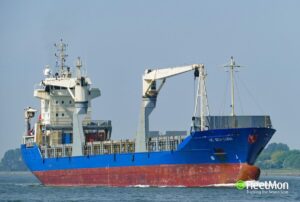Keel: The timber or bar forming the backbone of the vessel and running from the stem to the stempost at the bottom of the ship.
Keel-haul: To tie a rope about a man and, after passing the rope under the ship and bringing it up on deck on the opposite side, haul away, dragging the man down and around the keel of the vessel. As the bottom of the ship was always covered with sharp barnacles, this was a severe punishment used aboard sailing ships long ago. Today, a reprimand.

Keep a sharp look-out: A look-out is stationed in a position to watch for danger ahead. To be on guard against sudden opposition or danger.
King-spoke: The upper spoke of a steering wheel when the rudder is amidships, usually marked in some fashion (top spoke of neutral steering wheel).
Kink: A twist in a rope.
Knock off: To stop, especially to stop work.
Knocked down: The situation of a vessel when listed over by the wind to such an extent that she does not recover.
Knot: Speed of 1 nautical mile per hour (1.7 land miles per hour).
Knot: A twisting, turning, tying, knitting, or entangling of ropes or parts of a rope so as to join two ropes together or make a finished end on a rope, for certain purpose.
Labor: A vessel is said to labor when she works heavily in a seaway (pounding, panting, hogging and sagging).
Ladder: A metal, wooden or rope stairway.
Lame duck: Term for disabled vessel that had to fall out of a convoy and thus became easy prey for submarines.
Landlubber: The seaman’s term for one who does not go to sea.
Lanyard: A rope made fast to an article for securing it (knife lanyard, bucket lanyard, etc.), or for setting up rigging.
Lashing: A passing and repassing of a rope so as to confine or fasten together two or more objects; usually in the form of a bunch.
Launch: To place in the water.
Lay aloft: The order to go aloft (go up above).
Lazaretto: A low headroom space below decks used for provisions or spare parts, or miscellaneous storage.
Lee shore: The land to the leeward of the vessel (wind blows from the ship to the land).
Leeward: The direction away from the wind.
Liberty: Permission to be absent from the ship for a short period (authorized absence).
Life-line: A line secured along the deck to lay hold of in heavy weather; a line thrown on board a wreck by life-saving crew; a knotted line secured to the span between life-boat davits for the use of the crew when hoisting and lowering.
Line: A general term for light rope.
Logbook: A book containing the official record of a ship’s activities together with remarks concerning the state of the weather, etc.
Longitudinal: A fore and aft strength member of a ship’s structure.
Longshoreman: A laborer who works at loading and discharging cargo.
Lookout: The man stationed aloft or in the bows for observing and reporting objects seen.
Loom: The part of an oar between the blade and handle. The reflection of a light below the horizon due to certain atmospheric conditions.
Loose: To unfurl.
Lubber line: The black line parallel with ship’s keel marked on the inner surface of the bowl of a compass, indicating the compass direction of the ship’s head.
Lurch: The sudden heave of the ship.
Lyle gun: A gun used in the life-saving services to throw a life line to a ship in distress or from ship to shore and used when a boat cannot be launched.
Kindly like us on Facebook
















Discussion about this post